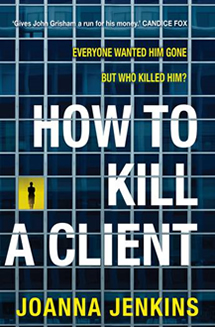Reviewed by Robert Goodman.
By Joanna Jenkins, Allen and Unwin.
 Joanna Jenkins exposes men behaving badly in the world of corporate law and business in her debut novel How to Kill a Client. This is one of a number of recent crime books that seeks to explore how far we have come, or not come, in the pursuit of gender equality usually focussing on domestic and family violence. How to Kill a Client is really interested in toxic power imbalances in the upper echelons of the corporate world. And while there is also an aspect of domestic abuse in this novel, it comes part of a package of what is still normalised and in some respects lauded behaviour in modern business.
Joanna Jenkins exposes men behaving badly in the world of corporate law and business in her debut novel How to Kill a Client. This is one of a number of recent crime books that seeks to explore how far we have come, or not come, in the pursuit of gender equality usually focussing on domestic and family violence. How to Kill a Client is really interested in toxic power imbalances in the upper echelons of the corporate world. And while there is also an aspect of domestic abuse in this novel, it comes part of a package of what is still normalised and in some respects lauded behaviour in modern business.
How to Kill a Client opens with news of the death of Gavin Jones from an unexpected heart attack. Jones was the inhouse lawyer for an international mining company and a major client of law firm Howard Greene. The partners at Howard Greene are looking for opportunity associated with Gavin’s demise but only one, Viv, is not afraid to say what everyone is actually thinking – that Gavin was not a nice person and not a great lawyer. Joanna Jenkins is going to reveal just why Viv felt that way.
After this prologue, the narrative drops back six months to the story of Sydney partner Ruth being talked into working from Brisbane where her law firm is looking at a shake-up. Viv, the Brisbane office’s only female partner and expert in competition law is meeting with Gavin Jones, the new in-house lawyer for Minerallic. Viv finds the encounter aggressive and belittling and later finds out that Gavin used the meeting to steal her ideas and claim them as his own. Meanwhile, the head of the Brisbane office is trying to make sure the firm keeps Gavin, and the millions of dollars of work his employer represents to the firm, onside. As the story progresses, Jenkins makes very clear what sexist, bullying and obnoxious person Gavin is. But she also shows how the boys club that is the partnership at the Brisbane office not only responds positively to this behaviour but supports it to the detriment of Viv in particular. Ruth calls this behaviour out to the managing partner in Sydney but despite their close relationship he refuses to believe what Ruth is telling him about the behaviour of his senior Brisbane staff. When Gavin dies suddenly there are plenty of suspects, including Viv, who openly thought about how she could kill him and get away with it.
What How to Kill Your Client shows very clearly is that no matter how far we think we have come in terms of equality in the work place there is still a lot of work to do. While some of the characters could possibly some across as caricatures, the behaviour portrayed is well documented – men stealing or claiming ownership of the ideas of women, successful women being accused of not being “team players”, constant undermining, domestic abuse and violence. Gavin succeeds because his behaviour is not only condoned but enabled. His techniques are supported by Viv’s male partners who are all crawling over each other for bigger bonusses and more prominence.
Jenkins begins the novel by being very clear that “none of the… characters in this book are real”. But while they may not be real, they are clearly based on experience. This book feels like a revenge fantasy and while it is not quite that, there is an element of wish fulfillment here. This is not a murder mystery in which anyone is invited to feel sorry for the victim. And while Gavin’s demise prompts some of those around him to rethink their attitude to how he behaved, they (and readers) do so knowing that the behaviours that he represents continue to be played out in boardrooms across the world.
Over 900 more book reviews can be found on Pile by the Bed.









